Adopted on 1918 Country Lithuania | Proportion 3:5 | |
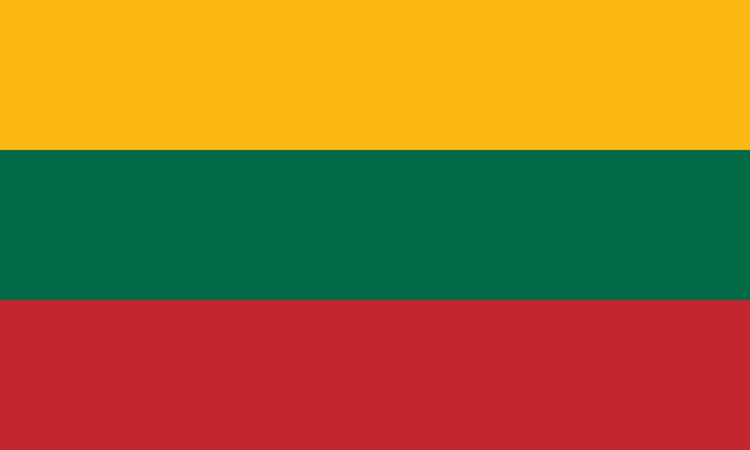 | ||
Design A horizontal triband of yellow, green and red. Use National flag, Civil ensign | ||
Flag of lithuania hd
The flag of Lithuania consists of a horizontal tricolor of yellow, green and red. It was re-adopted on March 20, 1989, almost two years before the re-establishment of Lithuania's independence and more than three years before the collapse of the Soviet Union.
Contents
- Flag of lithuania hd
- The flag of lithuania being raised at the un headquarters
- Historical state flag
- Creation of modern flag
- Soviet period
- Restoration of modern flag
- Design and symbolism
- State historical flag
- Flag protocol
- National flag days
- Other Lithuanian flags
- References
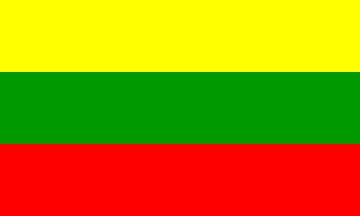
It was first used in Lithuania's first period of independence (in the 20th century) from 1918 to 1940, which ceased with the occupation first by Soviet Russia and Lithuania's illegal annexation into the Soviet Union, and then by Nazi Germany (1941–44). During the post-World War II Soviet occupation, from 1945 until 1989, the Soviet Lithuanian flag consisted first of a generic red Soviet flag with the name of the republic, then changed to the red flag with white and green bars at the bottom. The last alteration to the current flag occurred in 2004 when the aspect ratio changed from 1:2 to 3:5.
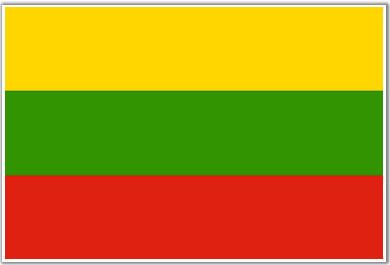
The flag of lithuania being raised at the un headquarters
Historical state flag
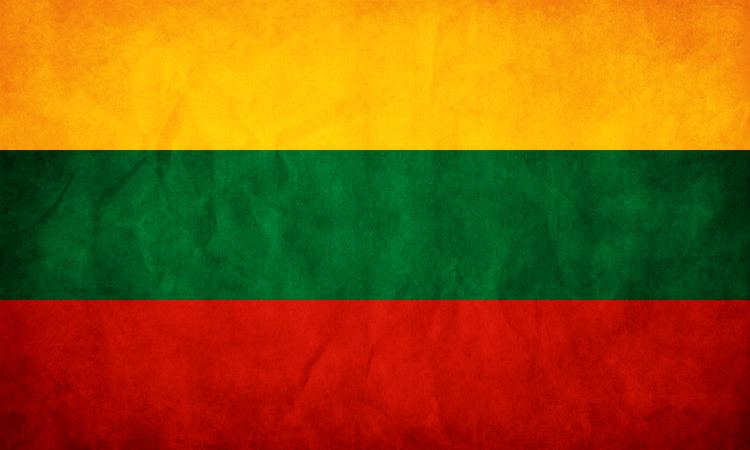
The earliest known flags with a Lithuanian identity were recorded in the 15th-century Banderia Prutenorum, written by Jan Długosz. At the Battle of Grunwald in 1410, two distinct flags were present. The majority of the 40 regiments carried a red banner depicting a mounted knight in pursuit. This flag, known as the Vytis, would eventually be used as the Lithuanian war flag, and again in 2004 as the state flag. The remainder of the regiments carried a red banner displaying the Columns of Gediminas. Those that bore the Vytis, also known as the Pahonia, were armies from the Grand Duchy of Lithuania, while those who bore the Columns of Gediminas were from noble families of Lithuania. Until the end of the 18th century, when it was annexed by the Russian Empire, the Grand Duchy of Lithuania used the Vytis as its flag.
Creation of modern flag
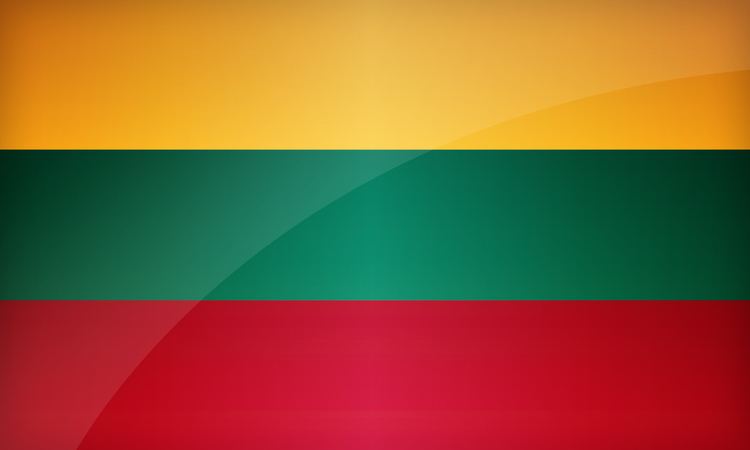
The birth of the yellow, green, and red tricolor occurred during a drive by other European republics to change their flags. One example that gave life to the idea of the tricolor was the French blue, white and red flag adopted after the French Revolution. The only tricolor that existed for Lithuania before the yellow, green and red flag was a green, white and red flag used to represent Lithuania Minor.
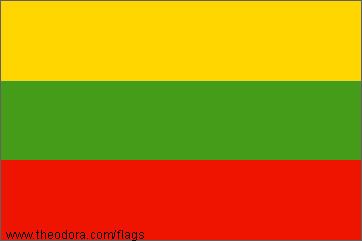
It is not known who originally suggested the yellow, green and red, but the idea is usually attributed to Lithuanian exiles living elsewhere in Europe or in the United States during the 19th century. These three colors were frequently used in folk weavings and traditional dress. At the Great Seimas of Vilnius of 1905, this flag was favored over the Vytis banner as the flag of the Lithuanian nation. The Vytis, strongly advocated by Jonas Basanavičius, was not chosen for three reasons: the first was that as part of the drive for national identity, the Seimas wished to distance itself somewhat from the flag of the Grand Duchy of Lithuania, which also encompassed now-distinct nations such as Belarus, and Ukraine. The second issue was the choice of the color red by revolutionaries who aligned themselves with Marxist or Communist causes. And finally, the flag with Vytis would be too complicated and could not be easily sewn.

Debates about the national flag occurred again in 1917 during the Vilnius Conference. Two colors, green and red, were chosen based on their prevalence in folk art. Artist Antanas Žmuidzinavičius decorated the conference hall with small red and green flags. However, the delegates did not like the design as it was too dark and gloomy. Then Tadas Daugirdas suggested adding a narrow strip of yellow (to symbolize the rising sun) in between the red (clouds lit up by the morning sun) and green (fields and forests). However, the delegates decided that the matter should be settled by a special commission, composed of Basanavičius, Žmuidzinavičius, and Daugirdas. On April 19, 1918, they submitted their final protocol to the Council of Lithuania. The flag was supposed to be a tri-color (yellow at the top, green in the middle, and red at the bottom) with Vytis in the upper left corner or in the middle. The Council accepted the proposal, but the 1922 Constitution of Lithuania did not include any mention of the coat of arms. It adopted the national flag that is used today. Any of the debates failed to produce a historical flag. Discussions of the national flag continued; its opponents considered gold an inappropriate color, since the combination of yellow, green and red did not follow the existing rules of heraldry. However, no changes were made during the inter-war period.
Soviet period
During World War II, Lithuania was occupied by the Soviet Union (1940–1941, 1944–1990) and Nazi Germany (1941–1944). The use of the national flag during this period was prohibited and prosecuted. Two flags were used during the period of Soviet occupation (1944–1989): immediately after the war, the flag consisted of a red field, golden hammer and sickle with the Latin characters LIETUVOS TSR (Lithuanian SSR in the Lithuanian language) above them in gold sans-serif lettering. That flag was replaced in 1953 by the last flag used by the Lithuanian Soviet Socialist Republic—a red flag, with the hammer and sickle and star in the hoist. At the bottom of the flag, a white and green horizontal bar was placed. The red portion of the flag took 8/12 of the flag's width, the white 1/12 and the green 3/12
Restoration of modern flag
During 1988, when the Lithuanian movement towards independence was gaining strength, the Lithuanian Supreme Soviet again recognized the tricolor as the national flag, by amending article 168 of the Constitution (Fundamental Law) of the Lithuanian SSR. The flag was defined as rectangular tricolor which consists of three equally sized horizontal stripes: the upper is yellow, the middle is green, the lower is red; the flag ratio was to be 1:2 (as that of Soviet flags). This flag was confirmed by the Provisional Constitution of 11 March 1990 № I-10.
After independence from the Soviet Union, the tricolor flag was written into the new Constitution of Lithuania, which was adopted by a referendum in 1992. This constitution has not specified the flag aspect ratio and therefore it has remained 1:2 until 2004, when 1991 law "On the national flag and other flags" was revised by 8 July 2004 law № IX-2331, making flag ratio 3:5.
Design and symbolism
Passed on June 26, 1991, the Law of the Republic of Lithuania on the Lithuanian State Flag governs the design, sizes and use of the state flag. The law was last amended on July 8, 2004, with the most notable changes including the switching of the national flag ratio from 1:2 to 3:5 and the official adoption of a historical flag as the state (government) flag. The amendment came into force on September 1, 2004, after it was approved by President Valdas Adamkus.
The yellow in the flag is meant to symbolize the sun and prosperity, the green is for the forests, the countryside, liberty, and hope, and the red represents the blood and bravery of those who have died for Lithuania. The proper colors of both the national and state flag are made according to the Pantone Matching System, specifically Pantone textile-paper (TP). The ratio of both the national and state flag must be 3:5, with the standard flag size to be 1 meter by 1.7 meters. Different sizes of the flag can be created, but they must conform to the color codes and ratio requirements set in the law. The official Pantone colors have been published since 2004; the list below shows the official colors and their suggested equivalents:
State (historical) flag
In 2004, along with the law authorizing the change of the flag ratio, a state flag was adopted. This flag displays the national emblem in a banner form. The ratio of the flag is the same as that of the national flag, i.e. 3:5. The state flag, called the historical flag in law, was proposed by Česlovas Juršėnas, the vice-speaker of the Seimas, and by Edmundas Rimša, the chairman of the Commission of Heraldry. This flag was also proposed at the same time as the grand coat of arms; both were meant to honor the 750th anniversary of the coronation of Mindaugas in 1253. The designer of the State (historic) flag and coat of arms was Arvydas Každailis. Historically, this flag was used during the Battle of Grunwald, and has served as the government flag for Central Lithuania from 1922 until 1939. This was one of the few flags considered to become the national flag during the drive for national independence. Several other countries, including Finland, Spain, Venezuela, Germany and Thailand, have an official national flag for civilian use and a state flag for government use.
Under the National Flag Law, the state flag is permanently hoisted at three locations: the Royal Palace of Lithuania, Trakai Island Castle, and the grounds of the Vytautas the Great War Museum in Kaunas. In addition, the flag is hoisted at the following locations on these days:
Flag protocol
The flag can be flown vertically or horizontally from public buildings, private homes, businesses, ships, town squares, or during official ceremonies. If the flag is flown horizontally, the yellow stripe must be at top; when flown vertically, the yellow stripe must be facing Left with the red stripe facing Right. While the flag should be flown from sunrise to sunset, government offices in Lithuania and abroad must fly the flag on a 24-hour basis. The flags must conform to the legal standards, and cannot be soiled or damaged in any way.
For mourning activities, the flag can be flown in either of the following ways. The first method, commonly known as half-staffing, is performed when the flag is hoisted to the top of the flagpole, then lowered to the pole's one-third position. The other method is to attach a black ribbon to a flag that is permanently affixed to a staff. The ribbon itself is ten centimetres wide and it is attached to the mast so that the ends of the ribbon reach the bottom of the flag. During a funeral ceremony, the flag may be used to cover the coffins of government officials, soldiers, signatories of the Act of the Re-Establishment of the State of Lithuania, and persons designated by an act of the President; these flags are later folded and presented to the next of kin before interment.
When flying the Lithuanian flag with other flags, the following is the correct order of precedence: The national flag, the historical (state) flag, flags of foreign states, the flag of the European Union, international NGOs, the presidential standard, military and government standards, county flags, city flags and any others. When foreign flags are used alongside the Lithuanian flag, the flags are sorted according to their countries' names in the Lithuanian language. The only exception is when the congress or meeting held in Lithuanian dictates a different language to be used for sorting. The European Union flag has been hoisted since Lithuania became a member of the organization. While not mentioned by name in the law, the flag of NATO can be used in Lithuania, since it belongs to that organization as well. It is also common to fly the flags of Estonia and Latvia during certain occasions, mainly the celebration of independence of the three Baltic states. The Law of the Republic of Lithuania on the National Flag and Other Flags governs the rules, use, protocol and manufacturing of the national and other flags used inside the country.
National flag days
As part of the flag protocol, the daily display of the Lithuanian flag is encouraged, but is strongly encouraged or legally required on the following days:
Apart from these days, the flag is flown at election polling sites. The national government, under Article 4, Section 7 of the flag law, is given the authority to call for the display of the national flag and to determine special conditions, such as marking for mourning.
Other Lithuanian flags
A naval ensign has been used by Lithuania starting in 1992. The ensign has a white background charged with a blue cross, with the national flag in the canton. The width of each cross is 1/7th of the total width of the ensign, with the ratio being 1:2. Historically, this flag was used as the ensign of the Kaunas Yacht Club, but with a different ratio of 2:3. The naval jack consists of a white field, charged with a blue anchor covered by the naval badge of Lithuania. The badge consists of the Columns of Gediminas in yellow on a red disc. A masthead pennant have been adopted by the Lithuanian Navy to use on their ships.
The President of Lithuania was officially given a standard by the Seimas in 1993. The standard is the State Emblem of Lithuania charged in the center on a single-color background. Under state law, the background color is stated as purple, but the color used in practice is dark red. The ratio of the standard is 1:1.2.
Each county of Lithuania has adopted a flag, each of them conforming to a pattern: a blue rectangle, with ten instances of the Cross of Vytis (double cross or) appearing in gold, acts as a fringe to the central feature of the flag, which is chosen by the county itself. Most of the central designs were adapted from the counties' coat of arms.
